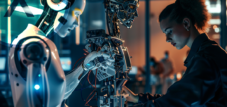Published on: May 17, 2025 / update from: May 17, 2025 - Author: Konrad Wolfenstein
Embodied ai in focus: the future of human-technology interaction
New dimensions of AI: from abstract models to real applications
Embodied artificial intelligence, also known as an Embodied AI, represents an innovative approach in AI research, in which intelligence does not exist in isolation in the digital space, but is created by integration into physical systems and active interaction with the real world. Unlike traditional AI systems that operate in abstract, virtual environments, Embodied Ai systems are able to perceive, understand and interact with it. This report offers a comprehensive overview of the principles, applications and future perspectives of the embodied AI.
Suitable for:
- Angelina Jolie? The humanoid robot Ameca, the person and machine connects - from trade fairs to museums he conquers the world
Basic concept of the embodied AI
Embodied artificial intelligence refers to AI systems that are embedded in physical objects such as robots and can interact with their surroundings in a significant way. In contrast to purely digital AI, which mainly produces digital artifacts or decision -making recommendations, Embodied Ai is aimed at controlling the behavior of physical systems.
The concept of the Embodied AI includes all aspects of interacting and learning in an environment: from perception and understanding to thinking and planning to execution. This holistic view differs fundamentally from classic computationalism, which sees mental processes as pure arithmetic operations and sees the brain as a computer.
A embodied AI uses sensors to capture their surroundings is learning and adaptable and, with their motor or reactive skills, converts perception processes in action processes. It has a contextual understanding and can also perform complex interactions in dynamic environments.
Theoretical foundations and philosophical background
The theoretical foundations of the Embodied Ai are deeply anchored in philosophy and cognitive science. The Embodiment hypothesis, which Linda Smith presented in 2005, states that thinking and learning are influenced by constant interactions between body and the surrounding area. This idea goes back to earlier philosophical concepts of the philosopher Maurice Merleau-Ponty, who emphasized the central role of perception and body for understanding.
Embodied cognition (Embodied cognition) represents a group of theories that examine how cognition is shaped by the physical condition and the abilities of the organism. These embodied factors include the motor system, the perception system, physical interactions with the environment and the assumptions about the world, which shape the functional structure of the brain and body of the organism. The thesis of embodied cognition challenges other theories such as cognitivism, computerism and Cartesian dualism.
The Embodied AI builds on these concepts and suggests that true artificial general intelligence (AGI) can be achieved by controlling physical embodiment and interaction with simulated and physical environments.
Technological components and functionality
The development of Embodied AI systems requires the integration of various technological components and methodologies:
Perception and sensors
Embodied Ai systems use various sensors to perceive their surroundings, similar to the classic five senses in humans. These sensors can include cameras (for visual understanding), microphones (for audio recording), tactile sensors (for touch and pressure), as well as acceleration and orientation sensors.
Cognitive processing
The cognitive architecture of a embodied AI comprises four essential components: perception, action, memory and learning. These components work together to enable the agent, to understand their surroundings and to react appropriately. Modern developments in this area include multimodal large models (MLLMS) that offer advanced perception, interaction and planning skills.
Actors and physical interaction
In contrast to passive observation, Embodied AI agents have an impact on their surroundings and learn from the reaction. This requires actuators - components that can carry out physical actions, such as robot arms, wheels or other mechanical systems.
Learning and adaptation mechanisms
Embodied AI systems learn through direct examination of their surroundings, similar to how people and animals learn through exploration and interaction. This includes various learning methodologies such as Reinforcement Learning, in which the agent learns through experiments and errors, as well as monitored and insurmountable learning.
Suitable for:
- Forget industrial robots! The humanoid robot Una from Ubtech is here to be your emotional companion in the service sector
Areas of application and examples
Embodied Ai is used in numerous areas:
Robotics and autonomous systems
From autonomous vehicles to drones and industrial robots - embodied KI enables these systems to perceive, navigate and interact with it. A simple example is the Roomba vacuum cleaner robot that uses sensors to navigate its physical environment, to recognize obstacles and to learn the interior design.
Production automation
In production, Embodied AI can control robot cells that carry out complex tasks such as grinding parts with the desired surface quality. The AI monitors the condition of the cells using sensors and generates instructions for the robot.
Healthcare and care
In the health sector, Embodied Ai promises a revolutionary change by offering solutions that improve precision, efficiency and personalization. Applications range from clinical interventions to daily care and accompaniment to post -interventional rehabilitation.
Agriculture
In agriculture, intelligent robots are being developed that can master the entire growing floral. For example, a research team from the Fudan University has developed a multifunctional robot that takes over the entire tomato cultivation, including pollination, leaf cleaning, fruit thinning and harvesting. This “thinking” machine can simulate human perception, decision -making and task.
Current research and developments
Multimodal Large Language Models (MLLMS)
A promising development in Embodied AI research is the integration of multimodal large voice models (MLLMS). These models process and integrate data from several sources such as text, images and audio, which enables comprehensive decision -making. They show remarkable versatility, skill and generalization ability in complex environments compared to traditional reinforcement learning approaches.
Benchmarks and evaluation platforms
Various benchmarks were developed to evaluate the performance of Embodied Ai. Embodiedbench, for example, is a comprehensive benchmark that was developed to evaluate Mllms as embodied agents. It offers a detailed evaluation of MLLM-based agents for both tasks on a high and low level and with six critical agent skills.
Another example is Embodiedeval, a comprehensive and interactive evaluation benchmark for MLLMS with embodied tasks. It comprises 328 different tasks within 125 different 3D scenes, which have been carefully selected and annotated.
SIM-to-real transmission
An important challenge in Embodied Ai Research is to transfer skills that have been acquired in simulations to real environments. This SIM-to-real transmission is an active research area that aims to close the gap between simulated and real environments.
The future of embodied intelligence: innovation and responsibility
Technical and practical hurdles
Although the development of the Embodied Ai has made great progress, there are still considerable challenges. This includes hardware restrictions, modeling modeling, physical understanding of the world and multimodal integration. The formulation of a new type of AI learning theory and the innovation of advanced hardware are critical of the development of robust and reliable embodied intelligence systems.
Ethical considerations
The development of Embodied Ai also raises ethical questions, especially with regard to security, privacy and possible social effects. It is important to develop and use these technologies responsibly in order to minimize potential negative consequences.
Future research directions
Several directions are outlined for the future of Embodied Ai Research. These include the development of Large perception cognition-behavior (PCB) models, physical intelligence and morphological intelligence. Central to these perspectives is the general agent framework, which is known as BCENT and integrates perception, cognitive and behavioral dynamics.
Why is AI representing the next stage of intelligent systems
Embodied Ai represents a paradigm shift in AI research, which emphasizes the importance of physical embodiment and interaction for the development of really intelligent systems. By integrating AI into physical systems and enabling direct interaction with the environment, Embodied Ai opens up new horizons for applications in areas such as robotics, healthcare, production and agriculture.
Current AI research is heavily driven by data, and the revolutionary breakthrough of the deep learning was carried out in areas of application in which data is easily available or can be generated. In Europe and especially in Germany, where social success is strong on technology and robotics, it is becoming increasingly important to focus on AI applications for machines.
Research in the area of Embodied AI requires a paradigm shift towards a holistic understanding of intelligence that does not exist isolated, but is manifested by a diverse, multimodal interaction with the environment. This vision of embodied intelligence could be the key to developing AI systems that are really adaptable and can thrive in dynamic environments.
Suitable for:
Your global marketing and business development partner
☑️ Our business language is English or German
☑️ NEW: Correspondence in your national language!
I would be happy to serve you and my team as a personal advisor.
You can contact me by filling out the contact form or simply call me on +49 89 89 674 804 (Munich) . My email address is: wolfenstein ∂ xpert.digital
I'm looking forward to our joint project.














